Bad News: Jonah Lehrer, 'Innocence of Muslims' Among The Worst Media Fails Of 2012
It’s a brave new world -- or maybe just a reckless one. The year 2012 saw one media industry train wreck after another, with the coverage of some big news stories making headlines of its own -- often for mistakes and poor judgment on the part of news outlets scrambling to compete in an increasingly competitive, digitally driven 24-hour news cycle. From Fox News to CNN to the New York Post, some of the country’s most recognizable news sources were forced to eat crow after misreporting essential facts or exploiting tragedies for page views.
The year 2012 also showed us how easy it has become to uncover plagiarism and fabrications -- easier than people like Jonah Lehrer and Mike Daisey were apparently counting on. And who would have thought that “self-plagiarism” would become a legitimate journalistic term?
But it has not all been a navel gazer’s delight. The bizarre video “Innocence of Muslims” showed us how destructive a hoax can be -- especially one intended to incite violence. Other tragic lows were the New York Post’s cover photo of a man about to be run over by a subway train, and the widespread misidentification of the Sandy Hook Elementary School shooter.
While it may not have been the most memorable story of 2012, IBTimes, too, is guilty of a major misfire: Our India bureau incorrectly reported on a presumed Internet ban in Iran, and the article gained widespread readership before our editors were able to publish a retraction. It was a humbling experience for all, one that showed just how quickly inaccurate information can spread and how difficult it is to erase our mistakes in the digital world.
Without further ado, here’s a recap of the biggest journalistic mishaps of 2012:

This American Liar: The Agony and The Ecstasy Of Mike Daisey
On Jan. 6, Public Radio International’s “This American Life,” hosted by Ira Glass, broadcast an excerpt of Mike Daisey’s monologue “The Agony and the Ecstasy of Steve Jobs,” a stage performance about conditions at a factory in China that produces Apple products, based primarily on what Daisey presumably learned during a weeklong visit there. Upon hearing the monologue, China-based “Marketplace” reporter Rob Schmitz noticed some discrepancies in Daisey’s account and what he knew about the Foxconn factory in Shenzhen that was the subject and setting of the monologue. After confirming that Daisey had fabricated some critical elements of the monologue, Schmitz contacted the producers at “This American Life,” who had done some significant fact-checking but were unable to uncover the inconsistencies that Schmitz identified.
In March, Ira Glass announced a retraction of the January story, and "This American Life" broadcast a follow-up episode where Glass doggedly questioned Daisey about misrepresentations in the monologue. The retraction segment found Daisey to be alternately contrite and defiant about the creative liberties he took in “The Agony and the Ecstasy of Steve Jobs.” During the lengthy and often uncomfortable interview, Daisey admitted that his work should not have been presented as journalistic fact, but insisted that his monologue should still be taken seriously as to draw needed attention to labor conditions in China.
“I’m not going to say that I didn’t take a few shortcuts in my passion to be heard,” Daisey said. “But I stand behind the work. My mistake ... is that I had it on your show as journalism and it’s not journalism. It’s theater.” Daisey has continued to perform a retooled version of the original monologue since the retraction episode aired. Promotions for the show characterize the “This American Life” controversy as one that led “to a national conversation about art and journalism, about truth-in-fact and essential truths, and about the role of truth in theater and storytelling.”

CNN And Fox News Fail To Check Themselves On SCOTUS Healthcare Ruling
On June 28, the U.S. Supreme Court voted to uphold President Obama’s Affordable Healthcare Act. But those following CNN and Fox News initially believed that the Supreme Court had struck down a central component of the act -- that all Americans would be required to have individual health insurance. Both outlets reported on the ruling in nearly real time as Chief Justice John Roberts announced the decision. At the start of his announcement, Roberts explained that the individual healthcare mandate was unconstitutional under the Commerce Clause, leading the CNN and Fox News reporters to conclude that the mandate had been struck down. In fact, by classifying the penalty to opt out of individual healthcare as a tax, the mandate sidesteps the Commerce Clause and is therefore constitutional -- but Roberts had not gotten that far in his explanation. Confusing? Sure thing. But the journalists should have known better than to pull the trigger before they were sure about the landmark ruling. Both CNN and Fox News quickly corrected their reports, and each issued a statement explaining their mistake -- but not before their fumble became bigger news than the healthcare act itself.

This Is Your Brain On Fiction: The Jonah Lehrer Implosion
Fallen wunderkind Jonah Lehrer faced compounded scandal this year via multiple breaches of journalistic ethics: The first minor, and another potentially career-ending that led to the discovery of yet further violations. The 31-year-old author, blogger and TED panelist had become immensely popular on the neuroscience circuit and was hired in June as a staff writer for the New Yorker. The prestigious lit mag also began hosting his blog, The Frontal Cortex, which had been a mainstay on Wired.com since July 2010. Very soon after Lehrer’s New Yorker hire, media industry commentator Jim Romenesko pointed out repeated instances of what quickly became known as “self-plagiarism”: Lehrer had borrowed, nearly verbatim, from his previously published work in other publications, like the Wall Street Journal, in some of his New Yorker pieces. The New Yorker responded by adding cautionary editorial notes to Lehrer’s work, apologizing for the duplication, but did not fire him.
Things quickly got worse for Lehrer. A fellow journalist and deeply knowledgeable Bob Dylan fan, Michael Moynihan, presumably tipped off by the self-plagiarism charges, launched an independent investigation into some unfamiliar Dylan quotes he had come across in Lehrer’s most recent best-seller, “Imagine: How Creativity Works.” For three weeks, Moynihan said, he worked with Lehrer to try and track down the questionable quotes, but was unable to do so -- as Lehrer had fabricated them. Moynihan published his findings on July 30 in Tablet magazine, and Lehrer resigned from the New Yorker in short order. “The lies are over now,” Lehrer said in an apology statement issued through his publisher (which yanked “Imagine” from bookstore shelves.)
Arriving a bit late to the party, Wired magazine -- which had until that point stood by its star blogger, and admitted that his work had not been edited or fact-checked -- subsequently arranged for an independent investigation of Lehrer’s writing, which unsurprisingly found what Wired editor-in-chief Evan Hansen described as “work that [did] not meet WIRED editorial standards.” The Frontal Cortex blog remains archived with an editor’s note on both Wired and the New Yorker, though Lehrer has not published, blogged or tweeted since this summer.

A Fake Filmmaker Releases A Fake Film -- And The Media Buys It
Shortly after the deadly attacks on the U.S. consulate in Benghazi and the protests at the embassy in Cairo, Americans understandably wanted answers and reporters were eager to uncover the facts behind the mayhem. But some outlets were a little too eager to accept the word of a phoner with an ax to grind against an entire religion. Both the Wall Street Journal and the Associated Press reported that the civil unrest was the result of an anti-Muslim film, directed by an Israeli-American named Sam Bacile, produced for $5 million and funded by 100 Jewish donors. The outlets had based their reports on a phone interview with a man who identified himself as Bacile. The problem? There is no Sam Bacile, and anyone who has seen the cheaply produced, shoddily dubbed YouTube video “Innocence of Muslims” would scarcely call it a film, let alone believe it was produced for anywhere near $5 million. The video is now believed to be the work of an Egyptian-born American named Nakoula Basseley Nakoula. And the 100 Jewish donors? Let’s just say that, if they exist, they got taken.

Tony Scott’s Mysterious Head Trip
ABC News got the ball rolling with this now-debunked report regarding the late filmmaker Tony Scott, but plenty of media outlets -- including IBTimes -- were guilty of fanning the fact-challenged flames. Shortly after the “Top Gun” director leapt to his death from a Los Angeles County bridge in August, ABC reported that Scott had inoperable brain cancer at the time of his apparent suicide. The network cited only a “source close to him,” but that didn’t stop the media echo chamber from repeating the claim, ad nauseam, across the Internet. The family disputed the report, and ABC later admitted it couldn’t confirm the story. Two months later, a coroner released a report stating that Scott had no serious medical conditions at the time of his death.

The Ghost of Jimmy Savile Haunts The BBC
The government-funded BBC left itself wide open for attack this year as its many critics took armchair pleasure in the “chaos” and “confusion” surrounding its botched handling of the ongoing Jimmy Savile scandal. British authorities believe the late Savile -- a once-beloved, now-reviled BBC personality -- may have sexually abused as many as 200 underage girls during his four-decade tenure. Savile died in 2011, but as posthumous allegations against the host mounted, the BBC mysteriously shelved an exposé into Savile’s alleged deeds. It wasn’t until a rival network aired its own exposé in October that the BBC was forced into a corner -- and heads rolled. Although an internal investigation found no evidence of a cover-up, incompetence abounded nonetheless.

The New York Post’s Train Wreck Of A Headline
It’s rare for one of the New York Post’s over-the-top headlines to become a headline in and of itself, but the maestros of yellow journalism outdid themselves in December when they published a front-page photo of a Queens man just seconds before he was stuck and killed by a subway train. “Pushed on the subway track, this man is about to die,” read the completely insensitive and totally uncalled-for headline. Readers and fellow news outlets were flabbergasted, as was Kevin Z. Smith, chairman of the Society of Professional Journalists’ ethics committee, who told IBTimes that the Post’s decision defied “any sense of professional, moral or ethical judgment.” Clearly reveling in the negative publicity, the Post one-upped itself the following day by running the very same photo on its cover again, this time under the conceit of “commenting” on the uproar. It was a big middle finger to all of its critics -- and to a dead man whose only crime was being on the wrong track at the wrong time.

Outing Private Ryan
The abundance of misinformation that unspooled in the wake of the school shooting in Newtown, Conn., should serve as a cautionary tale for any media organization, but the pièce de résistance in this factual Armageddon was the widespread misidentification of the shooter himself. In the hours following the massacre, a virtual who’s who of trusted news sources -- including CNN, NPR and the Associated Press -- identified Ryan Lanza of Hoboken, N.J., as the suspected perpetrator. Some outlets even linked to Ryan’s Facebook profile. So prevalent were the reports that Ryan posted several status updates telling everyone to “shut the f***k up it wasn’t me.” As everyone now knows, the mass shooter was quickly re-identified as Ryan’s younger brother, Adam, but poor Ryan’s Google search results may forever be unjustly tarnished as a result of the trigger-happy media.
© Copyright IBTimes 2024. All rights reserved.












